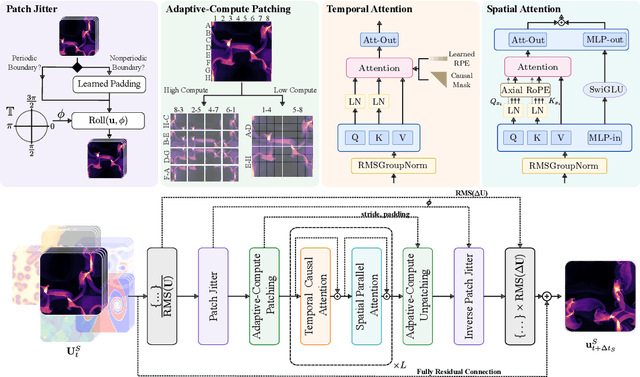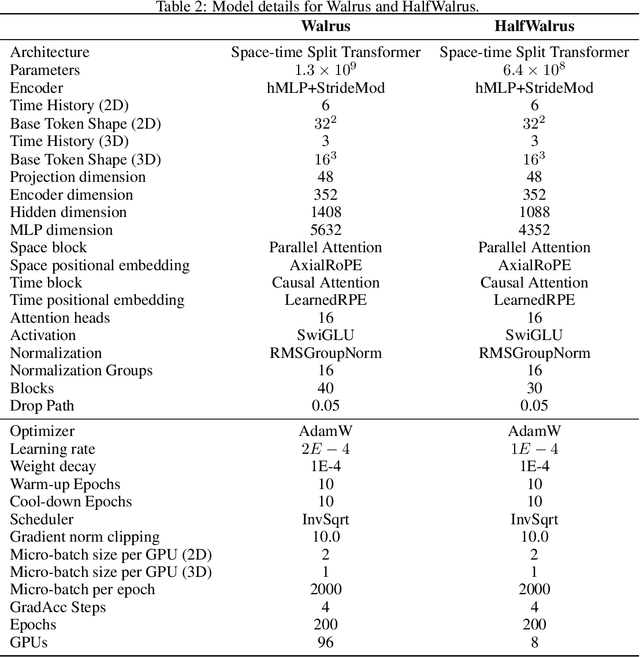Kyunghyun Cho
Walrus: A Cross-Domain Foundation Model for Continuum Dynamics
Nov 19, 2025



Abstract:Foundation models have transformed machine learning for language and vision, but achieving comparable impact in physical simulation remains a challenge. Data heterogeneity and unstable long-term dynamics inhibit learning from sufficiently diverse dynamics, while varying resolutions and dimensionalities challenge efficient training on modern hardware. Through empirical and theoretical analysis, we incorporate new approaches to mitigate these obstacles, including a harmonic-analysis-based stabilization method, load-balanced distributed 2D and 3D training strategies, and compute-adaptive tokenization. Using these tools, we develop Walrus, a transformer-based foundation model developed primarily for fluid-like continuum dynamics. Walrus is pretrained on nineteen diverse scenarios spanning astrophysics, geoscience, rheology, plasma physics, acoustics, and classical fluids. Experiments show that Walrus outperforms prior foundation models on both short and long term prediction horizons on downstream tasks and across the breadth of pretraining data, while ablation studies confirm the value of our contributions to forecast stability, training throughput, and transfer performance over conventional approaches. Code and weights are released for community use.
Generalist Foundation Models Are Not Clinical Enough for Hospital Operations
Nov 17, 2025Abstract:Hospitals and healthcare systems rely on operational decisions that determine patient flow, cost, and quality of care. Despite strong performance on medical knowledge and conversational benchmarks, foundation models trained on general text may lack the specialized knowledge required for these operational decisions. We introduce Lang1, a family of models (100M-7B parameters) pretrained on a specialized corpus blending 80B clinical tokens from NYU Langone Health's EHRs and 627B tokens from the internet. To rigorously evaluate Lang1 in real-world settings, we developed the REalistic Medical Evaluation (ReMedE), a benchmark derived from 668,331 EHR notes that evaluates five critical tasks: 30-day readmission prediction, 30-day mortality prediction, length of stay, comorbidity coding, and predicting insurance claims denial. In zero-shot settings, both general-purpose and specialized models underperform on four of five tasks (36.6%-71.7% AUROC), with mortality prediction being an exception. After finetuning, Lang1-1B outperforms finetuned generalist models up to 70x larger and zero-shot models up to 671x larger, improving AUROC by 3.64%-6.75% and 1.66%-23.66% respectively. We also observed cross-task scaling with joint finetuning on multiple tasks leading to improvement on other tasks. Lang1-1B effectively transfers to out-of-distribution settings, including other clinical tasks and an external health system. Our findings suggest that predictive capabilities for hospital operations require explicit supervised finetuning, and that this finetuning process is made more efficient by in-domain pretraining on EHR. Our findings support the emerging view that specialized LLMs can compete with generalist models in specialized tasks, and show that effective healthcare systems AI requires the combination of in-domain pretraining, supervised finetuning, and real-world evaluation beyond proxy benchmarks.
How to Find Fantastic Papers: Self-Rankings as a Powerful Predictor of Scientific Impact Beyond Peer Review
Oct 02, 2025Abstract:Peer review in academic research aims not only to ensure factual correctness but also to identify work of high scientific potential that can shape future research directions. This task is especially critical in fast-moving fields such as artificial intelligence (AI), yet it has become increasingly difficult given the rapid growth of submissions. In this paper, we investigate an underexplored measure for identifying high-impact research: authors' own rankings of their multiple submissions to the same AI conference. Grounded in game-theoretic reasoning, we hypothesize that self-rankings are informative because authors possess unique understanding of their work's conceptual depth and long-term promise. To test this hypothesis, we conducted a large-scale experiment at a leading AI conference, where 1,342 researchers self-ranked their 2,592 submissions by perceived quality. Tracking outcomes over more than a year, we found that papers ranked highest by their authors received twice as many citations as their lowest-ranked counterparts; self-rankings were especially effective at identifying highly cited papers (those with over 150 citations). Moreover, we showed that self-rankings outperformed peer review scores in predicting future citation counts. Our results remained robust after accounting for confounders such as preprint posting time and self-citations. Together, these findings demonstrate that authors' self-rankings provide a reliable and valuable complement to peer review for identifying and elevating high-impact research in AI.
Scaling Laws Are Unreliable for Downstream Tasks: A Reality Check
Jul 01, 2025Abstract:Downstream scaling laws aim to predict task performance at larger scales from pretraining losses at smaller scales. Whether this prediction should be possible is unclear: some works demonstrate that task performance follows clear linear scaling trends under transformation, whereas others point out fundamental challenges to downstream scaling laws, such as emergence and inverse scaling. In this work, we conduct a meta-analysis of existing data on downstream scaling laws, finding that close fit to linear scaling laws only occurs in a minority of cases: 39% of the time. Furthermore, seemingly benign changes to the experimental setting can completely change the scaling trend. Our analysis underscores the need to understand the conditions under which scaling laws succeed. To fully model the relationship between pretraining loss and downstream task performance, we must embrace the cases in which scaling behavior deviates from linear trends.
Why Knowledge Distillation Works in Generative Models: A Minimal Working Explanation
May 19, 2025Abstract:Knowledge distillation (KD) is a core component in the training and deployment of modern generative models, particularly large language models (LLMs). While its empirical benefits are well documented--enabling smaller student models to emulate the performance of much larger teachers--the underlying mechanisms by which KD improves generative quality remain poorly understood. In this work, we present a minimal working explanation of KD in generative modeling. Using a controlled simulation with mixtures of Gaussians, we demonstrate that distillation induces a trade-off between precision and recall in the student model. As the teacher distribution becomes more selective, the student concentrates more probability mass on high-likelihood regions at the expense of coverage--a behavior modulated by a single entropy-controlling parameter. We then validate this effect in a large-scale language modeling setup using the SmolLM2 family of models. Empirical results reveal the same precision-recall dynamics observed in simulation, where precision corresponds to sample quality and recall to distributional coverage. This precision-recall trade-off proves especially beneficial in scenarios where sample quality outweighs diversity, such as instruction tuning or downstream generation. Our analysis provides a simple and general explanation for the effectiveness of KD in generative modeling.
Machine Learning: a Lecture Note
May 06, 2025Abstract:This lecture note is intended to prepare early-year master's and PhD students in data science or a related discipline with foundational ideas in machine learning. It starts with basic ideas in modern machine learning with classification as a main target task. These basic ideas include loss formulation, backpropagation, stochastic gradient descent, generalization, model selection as well as fundamental blocks of artificial neural networks. Based on these basic ideas, the lecture note explores in depth the probablistic approach to unsupervised learning, covering directed latent variable models, product of experts, generative adversarial networks and autoregressive models. Finally, the note ends by covering a diverse set of further topics, such as reinforcement learning, ensemble methods and meta-learning. After reading this lecture note, a student should be ready to embark on studying and researching more advanced topics in machine learning and more broadly artificial intelligence.
RAGEN: Understanding Self-Evolution in LLM Agents via Multi-Turn Reinforcement Learning
Apr 24, 2025Abstract:Training large language models (LLMs) as interactive agents presents unique challenges including long-horizon decision making and interacting with stochastic environment feedback. While reinforcement learning (RL) has enabled progress in static tasks, multi-turn agent RL training remains underexplored. We propose StarPO (State-Thinking-Actions-Reward Policy Optimization), a general framework for trajectory-level agent RL, and introduce RAGEN, a modular system for training and evaluating LLM agents. Our study on three stylized environments reveals three core findings. First, our agent RL training shows a recurring mode of Echo Trap where reward variance cliffs and gradient spikes; we address this with StarPO-S, a stabilized variant with trajectory filtering, critic incorporation, and decoupled clipping. Second, we find the shaping of RL rollouts would benefit from diverse initial states, medium interaction granularity and more frequent sampling. Third, we show that without fine-grained, reasoning-aware reward signals, agent reasoning hardly emerge through multi-turn RL and they may show shallow strategies or hallucinated thoughts. Code and environments are available at https://github.com/RAGEN-AI/RAGEN.
Black Box Causal Inference: Effect Estimation via Meta Prediction
Mar 07, 2025



Abstract:Causal inference and the estimation of causal effects plays a central role in decision-making across many areas, including healthcare and economics. Estimating causal effects typically requires an estimator that is tailored to each problem of interest. But developing estimators can take significant effort for even a single causal inference setting. For example, algorithms for regression-based estimators, propensity score methods, and doubly robust methods were designed across several decades to handle causal estimation with observed confounders. Similarly, several estimators have been developed to exploit instrumental variables (IVs), including two-stage least-squares (TSLS), control functions, and the method-of-moments. In this work, we instead frame causal inference as a dataset-level prediction problem, offloading algorithm design to the learning process. The approach we introduce, called black box causal inference (BBCI), builds estimators in a black-box manner by learning to predict causal effects from sampled dataset-effect pairs. We demonstrate accurate estimation of average treatment effects (ATEs) and conditional average treatment effects (CATEs) with BBCI across several causal inference problems with known identification, including problems with less developed estimators.
An Overview of Large Language Models for Statisticians
Feb 25, 2025



Abstract:Large Language Models (LLMs) have emerged as transformative tools in artificial intelligence (AI), exhibiting remarkable capabilities across diverse tasks such as text generation, reasoning, and decision-making. While their success has primarily been driven by advances in computational power and deep learning architectures, emerging problems -- in areas such as uncertainty quantification, decision-making, causal inference, and distribution shift -- require a deeper engagement with the field of statistics. This paper explores potential areas where statisticians can make important contributions to the development of LLMs, particularly those that aim to engender trustworthiness and transparency for human users. Thus, we focus on issues such as uncertainty quantification, interpretability, fairness, privacy, watermarking and model adaptation. We also consider possible roles for LLMs in statistical analysis. By bridging AI and statistics, we aim to foster a deeper collaboration that advances both the theoretical foundations and practical applications of LLMs, ultimately shaping their role in addressing complex societal challenges.
Meta-Statistical Learning: Supervised Learning of Statistical Inference
Feb 19, 2025



Abstract:This work demonstrates that the tools and principles driving the success of large language models (LLMs) can be repurposed to tackle distribution-level tasks, where the goal is to predict properties of the data-generating distribution rather than labels for individual datapoints. These tasks encompass statistical inference problems such as parameter estimation, hypothesis testing, or mutual information estimation. Framing these tasks within traditional machine learning pipelines is challenging, as supervision is typically tied to individual datapoint. We propose meta-statistical learning, a framework inspired by multi-instance learning that reformulates statistical inference tasks as supervised learning problems. In this approach, entire datasets are treated as single inputs to neural networks, which predict distribution-level parameters. Transformer-based architectures, without positional encoding, provide a natural fit due to their permutation-invariance properties. By training on large-scale synthetic datasets, meta-statistical models can leverage the scalability and optimization infrastructure of Transformer-based LLMs. We demonstrate the framework's versatility with applications in hypothesis testing and mutual information estimation, showing strong performance, particularly for small datasets where traditional neural methods struggle.
 Add to Chrome
Add to Chrome Add to Firefox
Add to Firefox Add to Edge
Add to Edge